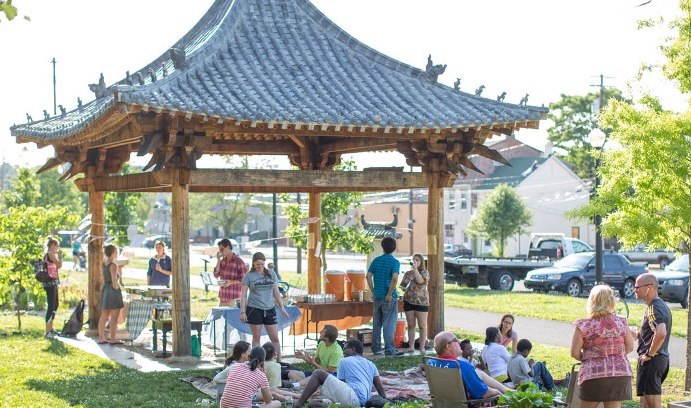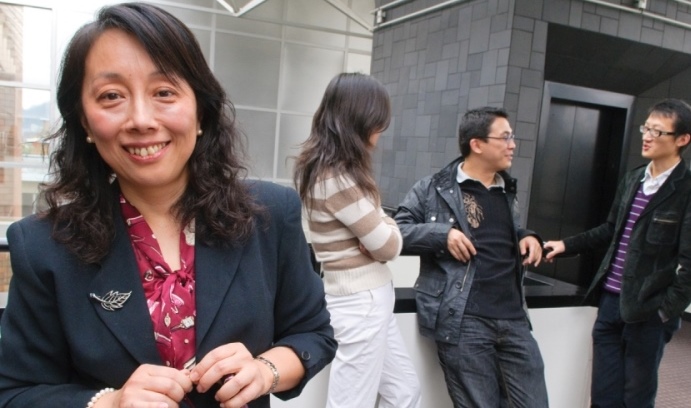The Invisible Red Silk Thread

The Chinese-Heting Harmony Pavilion on the South Bethlehem Greenway will be the stage this weekend when the Touchstone Theatre, with a major assist from Lehigh, presents “Journey from the East.” (Photo by Christa Neu)
Dongning Wang approached a middle-aged Asian man outside the Sands Casino Resort Bethlehem, where busloads of Asians arrive daily to escape New York City.
Why, Wang asked the man in Chinese, was he sitting on the curb without shoes or socks on?
The man answered that he was relaxing in “the countryside,” basking in the sun 80 miles and a world away from his home in Chinatown, to improve his poor health and his bad fortune.
Wang, an adjunct lecturer in modern languages and literature, was collecting stories for a two-part play about integrating Chinese and American cultures produced by Touchstone Theatre, a South Bethlehem company devoted to communal odysseys.
The first part, “Journey: Dream of the Red Pavilion,” staged last year, featured four women acting their Asian-American experiences. One of the performers was Wang, a cheerful cross-cultural ambassador and Beijing native who received a Ph.D. from Lehigh in 1998 in materials science and engineering.
Wang will also appear in the second play, “Journey from the East,” a free-wheeling adaptation of “Journey to the West,” an immensely popular 16th-century Chinese novel about a monk’s mission to secure saving scriptures from the Buddha.
The pilgrimage will unfold at 3 p.m. this Saturday and Sunday, April 18-19, and again on April 25-26 on the South Bethlehem Greenway, where Wang and her students interviewed Chinese New Yorkers on gambling mini-vacations. It will begin and end at the Chinese-Heting Harmony Pavilion, which was designed and built by a Lehigh team that included Wang and Norman Girardot, professor emeritus of religion studies, who has advised Touchstone on everything from Chinese folklore to Chinese-American fundraising.
Journeys in parallel
“Journey” began as a discussion between Girardot and Jp Jordan, Touchstone’s artistic director, about making the Harmony Pavilion more active and harmonious. Jordan envisioned the pavilion as a stage for an original production that would roam South Bethlehem. His vision tilted toward China when he discovered that the Asians practicing tai chi on the Greenway were casino refugees.
To shape “Journey,” Jordan and his Touchstone colleagues consulted a crack team of Lehigh scholar-citizens. Girardot is an authority on Chinese sacred systems and a biographer of James Legge, a Scottish translator of classic Chinese literary works. Constance Cook, a professor of Chinese language and literature, helped Girardot create the Harmony Pavilion and helped Wang make the rare transition from materials scientist to cultural historian-cheerleader.
In 2007 Wang began documenting Lehigh’s large and largely overlooked relationship with China. Aided by graduate students from China, she traced the association to the late 19th century, when Chinese students came to Bethlehem to study engineering to modernize their country’s steel industry. Some of these alumni pioneered science and business in their homeland; hall of famers include the builder of China’s first observatory and a textile mogul nicknamed the “Silk King.”
The research project launched Wang’s career as an academic diplomat. Through the Chinese Bridge Project in the College of Arts and Sciences, she helped Girardot, Cook and Tony Viscardi, professor of architecture, build a Chinese bridge over a South Mountain stream to symbolize the connection between Lehigh and China. She created a course in creative, or “free,” writing in Chinese to help China natives express themselves more independently. She helps young Asians move more independently by taking them to local restaurants, churches and touchstones like Touchstone.
Wang was the ideal guide for Touchstone ensemble associate Mary Wright, who wrote and directed “Journey: Dream of the Red Pavilion.” Wang introduced Wright to Chinese-speaking teachers, merchants and worshippers, all of whom agreed to be interviewed because they trusted Wang.
“Dongning opened up so many avenues,” says Wright, a veteran oral storyteller married to Benjamin Wright, professor of religion studies. “She was our connector.”
Inspired by Wright, Wang started Storytelling and Collecting, a course customized for the Touchstone project. Wang and her Chinese-speaking students interviewed a large assortment of Chinese-speaking visitors to the Bethlehem casino. In a park next door to Touchstone, they found a man who said he had lost his job as a welder in China, had been abandoned by a child in New York, and was living in a glorified closet. He took the bus to Bethlehem, he insisted, not to gamble but to earn $15 to $20 by selling a free gambling card worth $45.
A collection of personal stories
Meanwhile, Wright collected tales from China-raised Lehigh scholars interviewed by Emma Chong, a Touchstone ensemble member. Jinxin Fu, then a physics researcher, told Chong that he was profoundly influenced by the American film “12 Angry Men,” the story of a deadlocked jury.
Exposed to a more complex world, Wright changed “Journey: Dream of the Red Pavilion” from a tale about Bethlehem natives adjusting to casino “transients” to a more universal, personal tale about emotional migration. She anchored the play with the hybrid lives of four women: Chong, an American of Chinese ancestry; Liana Irvine, a Bethlehem high schooler adopted as a Chinese infant by an American family; Qiyi Zhu-Stoffey ’95 Ph.D., a China native and AT&T engineer, and Wang, a Christian who follows the Daoist philosophy that dreams are real.
Wang had to be coaxed to be herself. She was nervous about acting for the first time since she played a nine-year-old English-speaking African in a high-school production about American discrimination. Touchstone leaders convinced her she could be just as effective onstage as off.
“Dongning has such a natural, powerful presence,” says Wright. “She’s so passionate, so compassionate, so magnetic. She really represents how one person can be changed by history, and how one person can change history.”
Wang critiqued the “Red Pavilion” script with Norman Girardot, who steered Touchstone staffers to two Chinese performance artists who are serving as the company’s resident advisers. He also suggested that the ensemble base its second play on a famous chapter from “Journey to the West,” a fabled Chinese epic about a scripture-seeking monk and an entourage of demon fighters led by the Monkey King, a demigod comedian. Co-written by Bill George ’73, a Touchstone co-founder, “Journey from the East” is a slapstick fantasy where a Chinese diplomat and a U.S. president switch fantastic roles in a desperate Western town willing to gamble with its identity and destiny.
Girardot helped secure $20,000 for “Journey from the East” from the Henry Luce Foundation, which contributed over $600,000 to the Chinese Bridge Project and the Harmony Pavilion. His good deeds have prompted Touchstone leaders to crown him “the Monkey King.” Wang could be crowned “the Monkey Queen” for her community bridge building. Indeed, she escorted a group of Chinese casino visitors to the Chinese bridge on South Mountain to show them a shrine spiritually luckier than a gambling temple.
Wang personifies the Chinese belief that everyone and everything is tied by a thread of invisible red silk.
“People share more in common than differences,” she says. “We need to make more of an effort to integrate, to break the barrier. The world would be a better place if we tried to understand each other instead of guessing.”
Story by Geoff Gehman ’89 M.A.
Posted on:


